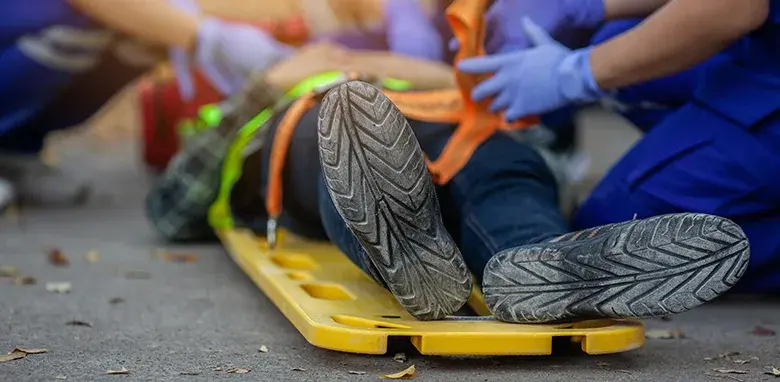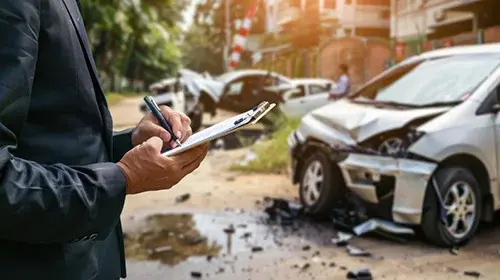Path to a Settlement:
A Guide to the Personal Injury Claim Process

If you’re caught in an accident, whether by car, truck, or anything else, your primary concern is getting back to normal. Unfortunately, the legal process to get there can be confusing, and riddled with barriers. Insurance companies are masterful at using the legal system to limit (or avoid) personal injury settlements.
The path from accident to potential settlement is tricky, and it helps to understand each step. A strong personal injury lawyer will guide you through this process, but you can prepare yourself by learning about each phase.
This guide will help you navigate the personal injury claim process, whether you’re searching for a legal partner or already retaining one.
Get a Free Case Consultation

Immediately After the Accident
The minutes and hours immediately after an accident are important in a personal injury case. Information and documentation collected at the site may form the foundation of your case, and the more context, the better.
If you’ve been in an accident, you’re likely reading this sometime afterward. But it’s worthwhile to check if these actions were completed after your incident. If they weren’t, try to follow up with the other driver(s) and collect any video or photo evidence.
If you haven’t been in an accident, this section can help you prepare for that possibility.
Here are the actions to take in the immediate aftermath of an accident:
Seek medical attention.
The first (and most important) act. If you need assistance from medical professionals, take it. If you can bring yourself to a hospital, do so. Even if you don’t feel any pain or detect anything wrong, get yourself checked physically and emotionally.
Some common injuries, such as whiplash, may not even appear until hours or days after the accident. Delaying treatment can make your injuries worse, and provides insurance companies with an easy excuse to question and potentially deny any injury claim.
Victims might not realize this at the moment, but pain and suffering claims extend beyond physical injuries. They also cover emotional and mental distress, which are referred to as noneconomic damages. These can significantly impact your overall well-being and quality of life, even if you don’t notice it at first.
Save your medical records.
Each visit to a hospital or clinic should come with an after-visit summary, detailing any tests, diagnosis, medications, and medical recommendations. These items will be attached to your electronic medical record (EMR), but make sure to save any paper copies from each visit.
Depending on the state, certain medical expenses are covered under personal injury claims, while others, like diagnostic tests, might not be covered. However, keeping your records allows your attorney to determine the extent of your injuries.
Collect photo and video evidence from the scene.
If you’re able to collect evidence before seeking medical attention, use the following steps to document everything:
- Use your cell phone to take pictures immediately, or shortly after the incident. This will help you show someone what the accident or hazard looked like.
- Use your cell phone to record any audio if you speak with affected parties or witnesses. Audio statements will help address conflicting evidence or testimony later.
- Send a text or call someone, like a loved one or friend, immediately after you get hurt. This will help you nearly pinpoint the time of the incident.
- Collect the names and contact information of anyone who offers assistance or speaks with you at the scene. These witnesses can provide their impressions as testimony.
Exchange information with other affected parties.
Many of us keep important documents, like insurance information, in our vehicles. After a car accident, remember to exchange information with the other driver(s) and grab your dashcam (if applicable). For non-vehicle accidents, exchange your information with any managers, homeowners, landlords, maintenance workers, or witnesses in the area.
Make sure to collect the names, addresses, insurance information, and contact information from other affected parties. Keep this information secure, and provide it to your attorney upon request.
File a police report.
In Minnesota, this step is non-negotiable for accidents resulting in injury, death, or property damage to an apparent extent of $1,000 or more. You must file a report with the police while on-site.
Even minor accidents should be reported to the police. While injuries may not be apparent immediately, an official police report may be helpful for any potential personal injury claim.
Do NOT admit fault.
It’s natural to apologize for an accident that may have been partially your fault, especially if it results in injuries. But don’t apologize or admit that the accident might be your fault.
As a general rule, don’t admit anything about the cause of the accident before talking to an attorney. Speaking about being at fault, even partially, might hurt your claim, especially if you did nothing wrong.
A Few Days After the Accident
After a few days, you hopefully have addressed any immediate medical or emotional needs. You now face several choices, along with some legal questions.
Here are the actions to take (or avoid) in the days after an accident:

DO NOT talk with an insurance company by yourself.
Minnesota is a no-fault insurance state, so you’ll work with your insurer for personal injury claims. Wisconsin is a fault state, which means you’ll work with the opposing party’s insurer if you can prove that the other party was at fault.
In either case, avoid talking to insurers yourself. Insurance adjusters do not have your best interests at heart. They want to settle the claim quickly and at the lowest possible cost to them. The initial offer is almost always too low. An attorney can help you craft and record a statement that answers any insurer's questions without compromising your case.
Think of this conversation as a starting point for negotiations. Despite what insurers might say, this is not your only shot to be compensated for your injuries, pain, and suffering.
Understand your rights.
If you suffer injuries in an accident, you may be eligible to recover compensation for medical bills and lost wages. Determining who can be held responsible for these costs depends on several factors, including who caused the accident and the ownership of insured vehicles or property involved.
Knowing your rights and the differences between how drivers, passengers, property owners, and victims are treated is important to receiving the highest possible compensation for your claim. State laws may also affect how much money you can seek for medical payments.
Contact and attain legal counsel.
A personal injury attorney can help protect your rights and obtain sufficient compensation for your injuries.
If you hire an attorney, they will notify all other parties involved that you have obtained legal representation, and are demanding compensation for your injuries. When someone pursues a personal injury claim, the claimant must notify all parties that they will be seeking compensation for their loss.
Attorneys can help clients obtain significantly higher settlements. At an initial consultation, the attorney will take the time to review your case and gain a detailed understanding of the accident and your situation.
Building the Case
Now that you’ve retained a personal injury attorney, they’ll perform most of the heavy lifting. However, the firm will require frequent communication as it builds your case.
Here are the actions that you and your attorney will take while building your case:
Investigate.
You and your attorney will review the facts of the case, any possible coverage issues with your insurance (or the other affected party’s insurance), and any evidence documented from the scene of the incident.
Your attorney may also review your insurance coverage to understand any subrogation provisions. This may happen if medical bills related to an auto accident or a work injury are sent to your health insurance. When your health insurer pays bills that were supposed to be paid by an insurer with a higher priority, then your insurer can legally try to recover the funds they paid.
Your attorney will also review any police reports and medical records gathered since the start of your legal journey, and share this information with all affected parties. This is part of the discovery process.

Keep your attorney updated.
Your attorneys can’t read your mind, and they aren’t medical professionals. They rely on you to provide essential updates and information, especially if anything changes with your medical condition.
For example, if you are referred to a specialist for further evaluation, tell your attorney immediately. They will obtain records from the specialist visit, prepare for potential legal implications, and ensure all medical expenses are accounted for in your claim. You should also mention any new out-of-pocket expenses incurred from post-accident treatment.
If you don’t keep your attorney updated, they might miss critical deadlines for filing documents, leading to delays or even dismissal of your case.
Gather witness statements.
Attorneys will collect statements from witnesses through depositions, which are question-and-answer sessions conducted in person or via video conference. Depositions usually occur at the attorney’s office, or another office within a conference room.
While depositions aren’t conducted inside a courtroom, witnesses must still swear to provide truthful testimony. While extremely rare, it is possible to face criminal perjury charges for lying during a sworn deposition.
If you are the party who has filed suit (or has been sued), you are required to sit for a deposition if the other side requests it.
Adjust for unique situations.
Sometimes, the case must continue without an affected party’s evidence or testimony. For example, if an at-fault driver dies in the accident, the case will rest on any other collected evidence from the scene.
While it is important to collect evidence in every accident situation, it is especially important if the person at fault died. The driver’s automobile insurance must still defend the claim, and you may still be entitled to damages based on the severity of your injuries.
Present the case.
After you and your attorney conduct research, collect evidence, and review your case, you’ll present the case to the insurer. This is known as a “demand package,” and it provides an overview of your case, documents the injuries you have sustained, and declares the desired compensation you are seeking.
The package must show that you were injured, that another party was at fault, and that you are entitled to a certain amount of damages.
Your personal injury case is a painstakingly crafted document that aims to prove you are entitled to compensation. Your attorney will walk you through each step of the process, confirm that the strategy makes sense, and advocate for your needs with the opposing party.
At this point, the case will either proceed to a settlement or advance to a trial.
Going to Trial
If your case is beyond reproach, the insurer might move straight to a settlement. But sometimes insurers will contest your case, either to reduce or dismiss the claim outright. Your case will now move into a courtroom, to be heard by a judge or jury.
If your case heads to a trial, here’s how it will be conducted:

-
Opening statements. In this stage, lawyers from both sides state their cases to the jury. Opening statements are typically restricted to fact-based statements rather than dramatic, persuasive arguments.
-
Presentation of evidence. Each side will present evidence to support their arguments while challenging the opposing side’s evidence. Evidence can include physical documents or testimony from relevant witnesses. Physical evidence usually appears as exhibits.
-
Witness testimony. If either side relies on testimony from witnesses, they must open the witnesses to examination. Witnesses swear to respond truthfully during their examinations, regardless of how they may impact either side’s argument. Each witness goes through direct examination and cross-examination.
-
Closing statements. In this stage, lawyers recap the evidence presented and make a final argument for their client. They are the lawyers’ final chance to influence the jury, and lawyers will use any evidence raised during the trial to make their case.
-
Jury instructions. After closing statements, the judge instructs the jury on how to render its verdict. Jury instructions explain the jury’s role and identify the laws that apply to the case. Judges will also remind jurors of any evidence that was deemed inadmissible before or during the trial—this means that the jurors can’t consider it when delivering their verdict.
-
Jury deliberations. Jurors leave the courtroom and evaluate the evidence in a private room. Depending on the state, civil case jurors must render either a majority or unanimous verdict.
-
Verdict. If a verdict is reached, the jury foreperson (or the judge) will read it to the court.
Settlement
If you avoided a trial and reached a settlement, congratulations. Settling a case is not an easy decision, but you’ve considered your options and chosen a path that best protects your interests.
A settlement is usually a compromise, and you likely didn’t get everything you would have hoped for. However, settlements are often a better option than facing the risks associated with continuing litigation.
Here are the actions to take when receiving a settlement:
Review the settlement terms.
A settlement is a legal contract between you and the opposing party, stating how much compensation you will receive because of your damages. Settlements usually outline the following types of damages:
-
-
General damages, which cover losses from pain and suffering and your injuries
-
Special damages, which cover any additional expenses, like missed work, lost wages, or household assistance
-
Crucially, settlements also indicate that, upon signing, you cannot seek further compensation from the insurer for the same injury.

Receive payment.
If you accept the settlement’s compensation amounts, you will also need to choose how to receive them. Settlement compensation can be paid out as a lump sum, or through structured payments over time.
-
-
Lump-sum payments are one-time, in-full payments. You’ll receive the entire amount in a single payment, which you can choose to invest however you please. You may also be taxed for a portion of the sum.
-
Structured settlement payments are tax-free payments delivered over time, instead of a lump sum. The payment schedule can be customized to meet your needs, such as payments for life, over a set period of years, or delayed until you reach a certain age.
-
Getting Back to Normal
Accidents and personal injuries can upend your life. Whether you’re dealing with a personal injury claim now, or you want to prepare for that possibility, it helps to understand the process.
If you’re mired in a post-accident maze of legal questions, documents, calls, and loopholes, we can help you get back to normal. We tackle big and small cases alike, so contact us if you need help.